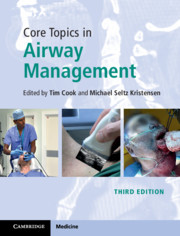Book contents
- Core Topics in Airway Management
- Core Topics in Airway Management
- Copyright page
- Contents
- Contributors
- Foreword
- Preface to the Third Edition
- Section 1 Airway Management: Background and Techniques
- Section 2 Airway Management: Clinical Settings and Subspecialties
- Section 3 Airway Management: Organisation
- Index
- References
Section 1 - Airway Management: Background and Techniques
Published online by Cambridge University Press: 03 October 2020
- Core Topics in Airway Management
- Core Topics in Airway Management
- Copyright page
- Contents
- Contributors
- Foreword
- Preface to the Third Edition
- Section 1 Airway Management: Background and Techniques
- Section 2 Airway Management: Clinical Settings and Subspecialties
- Section 3 Airway Management: Organisation
- Index
- References
Information
- Type
- Chapter
- Information
- Core Topics in Airway Management , pp. 1 - 184Publisher: Cambridge University PressPrint publication year: 2020
